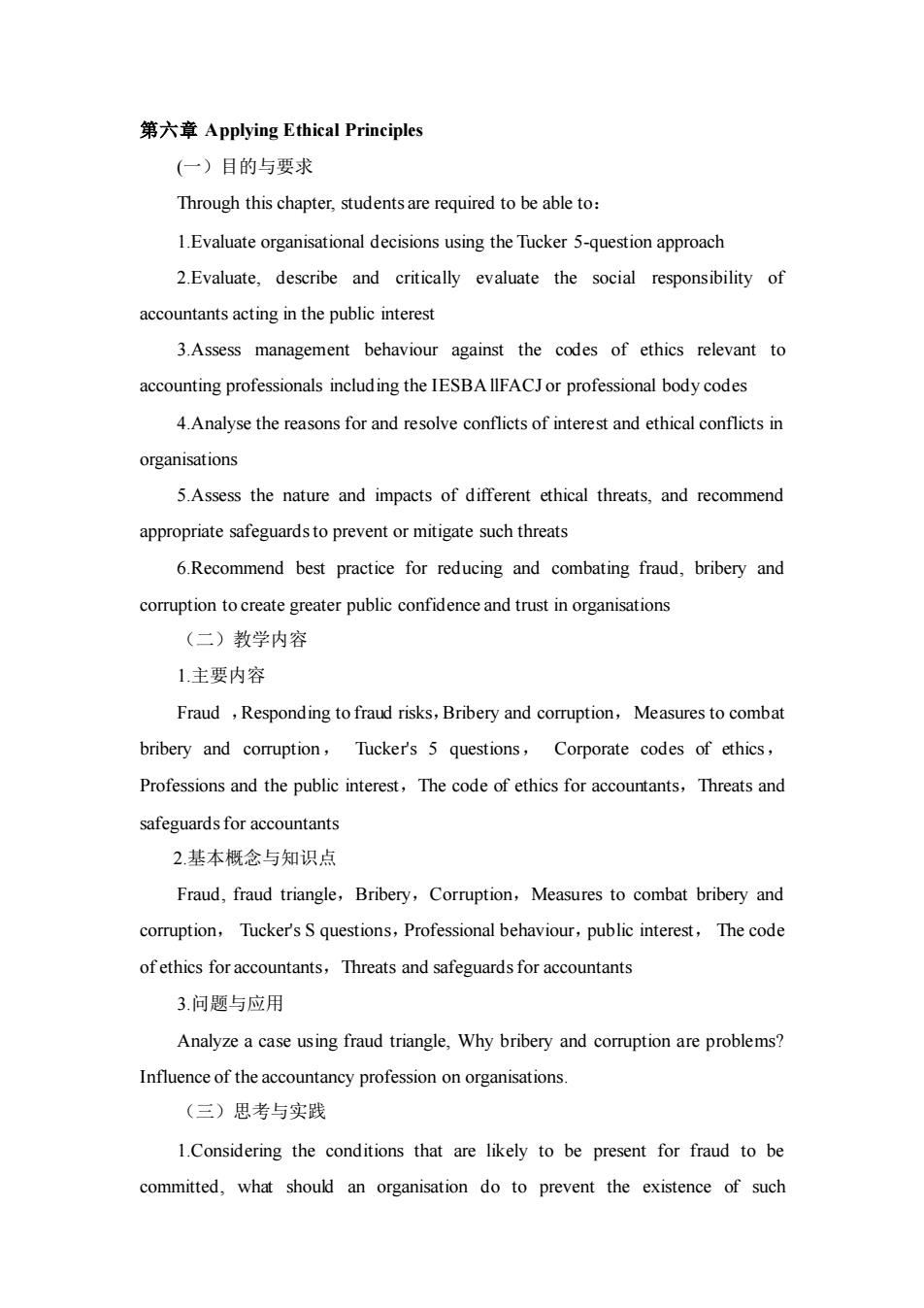正在加载图片...

第六章Applying Ethical Principles (一)目的与要求 Through this chapter.students are required to be able to: 1.Evaluate organisational decisions using the Tucker 5-question approach 2.Evaluate,describe and critically evaluate the social responsibility of accountants acting in the public interest 3.Assess management behaviour against the codes of ethics relevant to accounting professionals including the professional body codes 4.Analyse the reasons for and resolve conflicts of interest and ethical conflicts in organisations 5.Assess the nature and impacts of different ethical threats,and recommend appropriate safeguards to prevent or mitigate such threats 6.Recommend best practice for reducing and combating fraud,bribery and corruption tocreate greater public confidence and trust in organisations (二)教学内容 1.主要内容 Fraud Responding to fraud risks,Bribery and corruption,Measures to combat bribery and corruption,Tucker's 5 questions,Corporate codes of ethics, Professions and the public interest,The code of ethics for accountants,Threats and safeguards for accountants 2.基本概念与知识点 Fraud,fraud triangle,Bribery,Corruption,Measures to combat bribery and corruption,Tucker'sS questions,Professional behaviour,public interest,The code ofethics for accountants,Threats and safeguards for accountants 3.问题与应用 Analyze a case using fraud triangle,Why bribery and corruption are problems? Influence of the accountancy profession on organisations. (三)思考与实践 1.Considering the conditions that are likely to be present for fraud to be committed,what shoul an organisation do to prevent the existence of such 第六章 Applying Ethical Principles (一)目的与要求 Through this chapter, students are required to be able to: 1.Evaluate organisational decisions using the Tucker 5-question approach 2.Evaluate, describe and critically evaluate the social responsibility of accountants acting in the public interest 3.Assess management behaviour against the codes of ethics relevant to accounting professionals including the IESBA llFACJ or professional body codes 4.Analyse the reasons for and resolve conflicts of interest and ethical conflicts in organisations 5.Assess the nature and impacts of different ethical threats, and recommend appropriate safeguards to prevent or mitigate such threats 6.Recommend best practice for reducing and combating fraud, bribery and corruption to create greater public confidence and trust in organisations (二)教学内容 1.主要内容 Fraud ,Responding to fraud risks,Bribery and corruption,Measures to combat bribery and corruption, Tucker's 5 questions, Corporate codes of ethics, Professions and the public interest,The code of ethics for accountants,Threats and safeguards for accountants 2.基本概念与知识点 Fraud, fraud triangle,Bribery,Corruption,Measures to combat bribery and corruption, Tucker's S questions,Professional behaviour,public interest, The code of ethics for accountants,Threats and safeguards for accountants 3.问题与应用 Analyze a case using fraud triangle, Why bribery and corruption are problems? Influence of the accountancy profession on organisations. (三)思考与实践 1.Considering the conditions that are likely to be present for fraud to be committed, what should an organisation do to prevent the existence of such